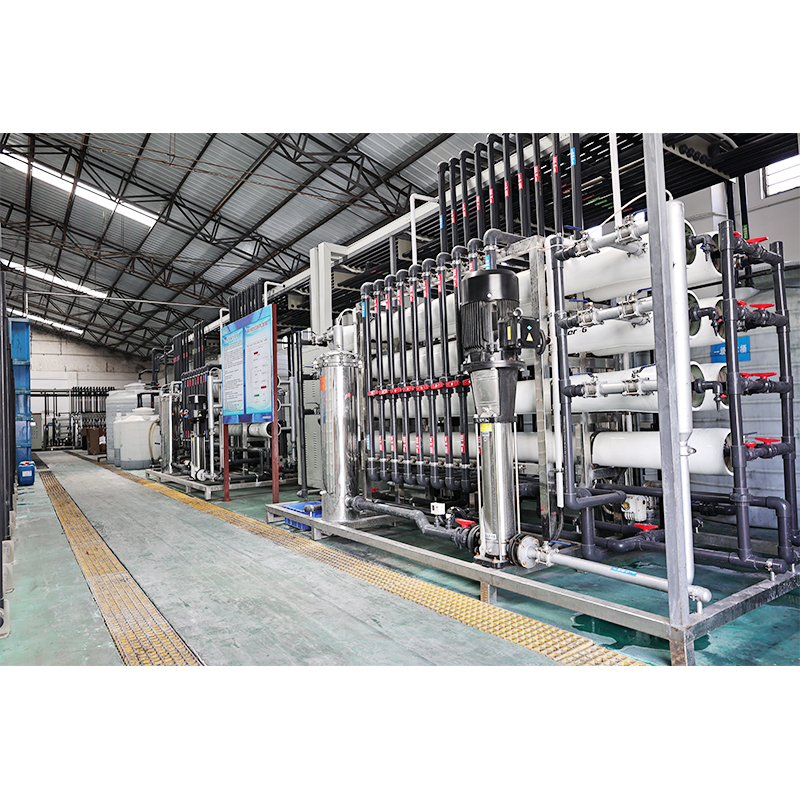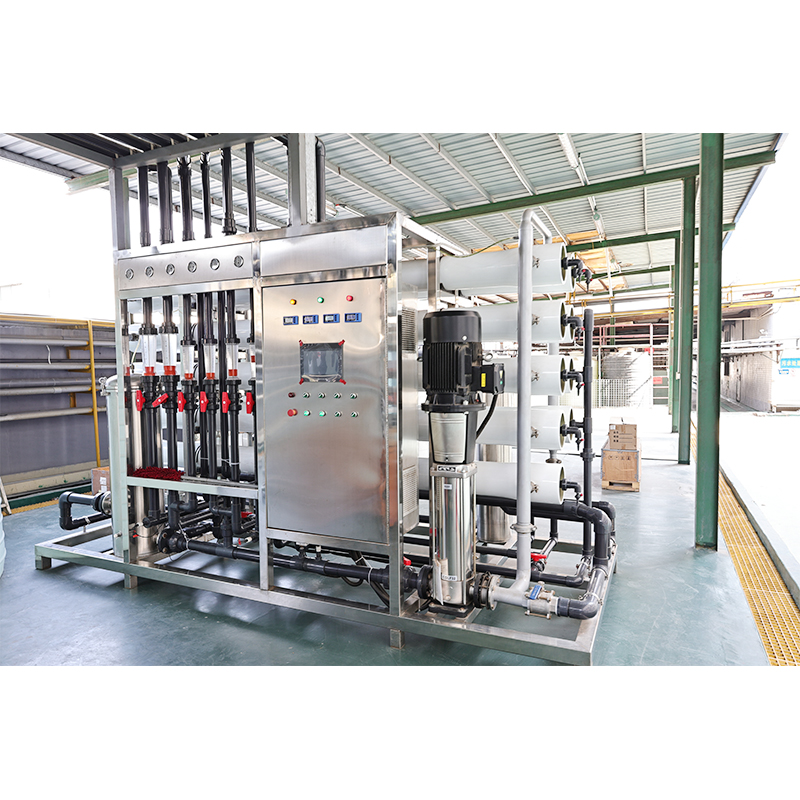How does an industrial RO membrane achieve low energy consumption?
Release Time : 2025-10-14
Against the backdrop of increasingly scarce water resources and rising energy costs, industrial reverse osmosis (RO) systems, as a key technology for high-purity water production, wastewater reuse, and seawater desalination, have made their operating energy consumption a key concern for companies. Traditional RO systems rely on high-pressure pumps to pressurize raw water to 10–70 bar to overcome osmotic pressure, and electricity consumption can account for over 40% of total water treatment costs. Therefore, achieving low energy consumption has become a key focus in the design and optimization of industrial RO systems. Through technological innovation, system integration, and intelligent management, industrial RO membranes are continuously evolving towards greater efficiency and energy conservation.
1. High-Efficiency Membrane Elements: Reducing Operating Pressure at the Source
The industrial RO membrane is the core of the system, and its performance directly determines its energy consumption. The new generation of low-pressure and ultra-low-pressure composite membranes utilize thinner separation layers and an optimized polyamide structure to significantly reduce required operating pressure while maintaining high salt rejection rates. For example, when treating surface water or groundwater, traditional systems require a pressure of 15 bar, while ultra-low-pressure membranes achieve the same water output at only 10–12 bar, significantly reducing the power requirements of the high-pressure pump. Furthermore, high-flux membranes can increase water production at the same pressure, indirectly reducing energy consumption per unit of water produced.
2. Energy Recovery Devices: Turning Waste into Treasure, Improving Energy Efficiency
During the reverse osmosis process, the brine still carries a significant amount of pressure energy. Traditional systems simply discharge this energy, resulting in energy waste. Modern industrial RO systems are commonly equipped with energy recovery devices, such as isobaric exchangers, turbochargers, or pressure exchange pumps. These devices recover the pressure energy of the brine and transfer it to the feed water, allowing the high-pressure pump to maintain system pressure only by replacing lost energy. In seawater desalination systems, energy recovery efficiencies can reach over 90%, reducing overall energy consumption by 50–60%, making them a key technology for achieving low-energy operation.
3. Intelligent Frequency Conversion Control: Adjusting on demand to avoid over-pressurization
The feed water quality, temperature, and demand for reverse osmosis systems often fluctuate over time. High-pressure pumps operating at a fixed frequency are prone to overpressure, wasting energy. An intelligent control system using variable frequency drive technology dynamically adjusts the high-pressure pump speed based on real-time monitoring of inlet water pressure, flow rate, and water production demand, precisely matching the system load. For example, reducing pump speed at night or during off-peak hours ensures stable water production while avoiding unnecessary energy consumption, achieving "power on demand."
4. Optimizing System Design: Reducing Resistance and Improving Efficiency
System piping design has a significant impact on energy consumption. Using large-diameter pipes and reducing elbows and valves can reduce flow resistance and pressure loss. Appropriate inter-stage configuration and inter-stage pressurization design balance the load across the membranes, avoid local concentration polarization, extend cleaning cycles, and maintain efficient operation. Furthermore, the modular design facilitates system expansion and maintenance, reducing downtime and energy consumption.
5. Enhanced Pretreatment: Protects membrane elements and reduces operating resistance.
Suspended solids, colloids, organic matter, and microorganisms in raw water easily deposit on the membrane surface, causing fouling and increasing operating pressure. An efficient pretreatment system can significantly reduce the risk of membrane fouling, maintain stable membrane flux, and reduce the need for continuous pressurization from high-pressure pumps. Regular chemical cleaning and online monitoring also help promptly detect fouling trends and maintain efficient system operation.
6. Intelligent Management: Data-Driven Energy-Saving Optimization
Modern industrial RO systems integrate PLC or SCADA monitoring platforms to collect real-time data on parameters such as pressure, flow, conductivity, and temperature. Through data analysis, they identify energy consumption anomalies and optimize operational strategies. Some systems also support remote operation and maintenance and AI-based prediction algorithms to automatically adjust operating parameters for long-term energy savings.
The low energy consumption of industrial RO membranes is the result of the synergistic effect of high-efficiency membrane elements, energy recovery technology, intelligent control, optimized design, and scientific management. Through technological innovation and system integration, companies can not only significantly reduce operating costs, but also reduce carbon emissions and enhance sustainable development capabilities.
1. High-Efficiency Membrane Elements: Reducing Operating Pressure at the Source
The industrial RO membrane is the core of the system, and its performance directly determines its energy consumption. The new generation of low-pressure and ultra-low-pressure composite membranes utilize thinner separation layers and an optimized polyamide structure to significantly reduce required operating pressure while maintaining high salt rejection rates. For example, when treating surface water or groundwater, traditional systems require a pressure of 15 bar, while ultra-low-pressure membranes achieve the same water output at only 10–12 bar, significantly reducing the power requirements of the high-pressure pump. Furthermore, high-flux membranes can increase water production at the same pressure, indirectly reducing energy consumption per unit of water produced.
2. Energy Recovery Devices: Turning Waste into Treasure, Improving Energy Efficiency
During the reverse osmosis process, the brine still carries a significant amount of pressure energy. Traditional systems simply discharge this energy, resulting in energy waste. Modern industrial RO systems are commonly equipped with energy recovery devices, such as isobaric exchangers, turbochargers, or pressure exchange pumps. These devices recover the pressure energy of the brine and transfer it to the feed water, allowing the high-pressure pump to maintain system pressure only by replacing lost energy. In seawater desalination systems, energy recovery efficiencies can reach over 90%, reducing overall energy consumption by 50–60%, making them a key technology for achieving low-energy operation.
3. Intelligent Frequency Conversion Control: Adjusting on demand to avoid over-pressurization
The feed water quality, temperature, and demand for reverse osmosis systems often fluctuate over time. High-pressure pumps operating at a fixed frequency are prone to overpressure, wasting energy. An intelligent control system using variable frequency drive technology dynamically adjusts the high-pressure pump speed based on real-time monitoring of inlet water pressure, flow rate, and water production demand, precisely matching the system load. For example, reducing pump speed at night or during off-peak hours ensures stable water production while avoiding unnecessary energy consumption, achieving "power on demand."
4. Optimizing System Design: Reducing Resistance and Improving Efficiency
System piping design has a significant impact on energy consumption. Using large-diameter pipes and reducing elbows and valves can reduce flow resistance and pressure loss. Appropriate inter-stage configuration and inter-stage pressurization design balance the load across the membranes, avoid local concentration polarization, extend cleaning cycles, and maintain efficient operation. Furthermore, the modular design facilitates system expansion and maintenance, reducing downtime and energy consumption.
5. Enhanced Pretreatment: Protects membrane elements and reduces operating resistance.
Suspended solids, colloids, organic matter, and microorganisms in raw water easily deposit on the membrane surface, causing fouling and increasing operating pressure. An efficient pretreatment system can significantly reduce the risk of membrane fouling, maintain stable membrane flux, and reduce the need for continuous pressurization from high-pressure pumps. Regular chemical cleaning and online monitoring also help promptly detect fouling trends and maintain efficient system operation.
6. Intelligent Management: Data-Driven Energy-Saving Optimization
Modern industrial RO systems integrate PLC or SCADA monitoring platforms to collect real-time data on parameters such as pressure, flow, conductivity, and temperature. Through data analysis, they identify energy consumption anomalies and optimize operational strategies. Some systems also support remote operation and maintenance and AI-based prediction algorithms to automatically adjust operating parameters for long-term energy savings.
The low energy consumption of industrial RO membranes is the result of the synergistic effect of high-efficiency membrane elements, energy recovery technology, intelligent control, optimized design, and scientific management. Through technological innovation and system integration, companies can not only significantly reduce operating costs, but also reduce carbon emissions and enhance sustainable development capabilities.







